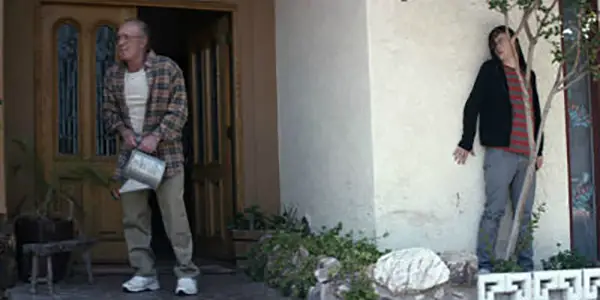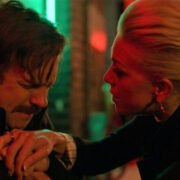THE GOOD NEIGHBOR: Hidden Secrets & Haunted Truths

Chris is a B.A.H. graduate with a concentration in pre-19th…
Do you know your neighbours? Even if you believe that you do, you might not actually know them. Although the person next door or across the street may seem normal, you only see the surface. Behind closed doors, there’s no guarantee you know who the person is beneath that exterior. Unfortunately, the same extends to friends; nobody is ever who they appear at first. This is the basic premise at the centre of Kasra Farahani ’s directorial debut, The Good Neighbor .
At the heart of the film is the duality of appearance versus reality, whether there is a difference, like Hitchc*ck’s Rear Window set in the digital age. The Good Neighbor is a tale of truth and lies that uses horror conventions in order to drive the plot, distracting and intriguing the viewer in equal measures. Its main focus is distorting perception, just as our own perceptions of the people in our neighbourhood might be skewed.
Following two young men – Ethan (Logan Miller) and Sean (Keir Gilchrist) – the film concerns their social experiment of spying on a mysterious, older neighbour named Harold Grainey (James Caan). Using advanced technology and an elaborate computer setup, their plan is to watch Grainey and slowly try convincing him that his house is haunted. Except, their plan is marred by false judgements and secrets, which threaten the safety of everyone involved.
Perspective and Haunted Memory
The screenplay by Mark Bianculli and Jeff Richard examines memory by constantly diverting exposition. At various points, the viewer slips into Grainey’s memories. Their seamless visual flow, taking us from the present to the past with little acknowledgement, is a technique which places us at the plot’s mercy, in that we’re never ahead of the characters.
As Ethan and Sean do surveillance on Grainey, we are never privy to any more information than they see. Sometimes, not even that. For instance, at one point Sean discovers something surprising on Ethan’s computer, though we don’t see it and are left in the dark until later. The screenplay weaves through past and present, teasing us about what’s happened and where the story’s headed next.

Farahani defers viewer satisfaction by going from scenes of Ethan and Sean in front of their computers keeping an eye on Grainey, to courtroom scenes warning us of a horrific resolution to the social experiment. All the while, we’re kept wondering how the plot can possibly play out. In-between, the pretend hauntings Ethan and Sean perpetrate allow us insight into Grainey’s memories.
Hidden Motives Run Amok
Partway through, we come to discover that Ethan has an entirely different reason for wanting to haunt Harold Grainey. This shifts the film on its axis because now there’s more than simply the possibility that Grainey isn’t who he seems. In today’s post 9/11 society, too many people tend to see things in their neighbourhood that might not be there, and all due to paranoia. Representative of real life, Ethan harbours negative perceptions of his neighbour, which cloud his judgement fatally.
Grainey, a neighbour, is one thing; those we’re not close to don’t always reveal their true selves. But Ethan and Sean are close friends who ought to know one another well. Instead, Ethan lies to Sean, who might not otherwise have even helped in the beginning if he knew his friend’s ulterior motives. Coupled with the finale, Ethan proves that we never truly know anybody; not our closest friends, and certainly not the old man across the street.

Ethan hides his true motives for keeping an eye on Grainey from Sean. Moreover, neither Sean nor Ethan know anything about his personal life. This makes the fake hauntings feel real for the old man. Inadvertently, the young men tap into his worst memories. The results are devastating. It isn’t until after the climactic moments of the film that the viewer discovers the ultimate tragedy and truth about Grainey. Afterward, we unravel the mystery of appearance until the reality of his character is laid bare. The truth about him, compounded by what Ethan and Sean precipitated with their surveillance and fake hauntings, makes judging one’s neighbour a disaster waiting to happen.
A Little Judgement is a Dangerous Thing
At a point in history when we’ve seen young people take their lives because of internet bullying and harassment, The Good Neighbor is a rumination on how hastily judging others without knowing them can mean more than innocent, harmless pranks. The social experiment Ethan and Sean undertake is not meant to hurt anybody, which is usually the excuse of anybody caught negatively affecting the lives of others, such as they do to Grainey.

Hitchc*ck ’s aforementioned Rear Window culminates with the discovery of a crime, after James Stewart draws us into his paranoid perspective. Similarly, Farahani ’s The Good Neighbor brings us into the perspective of two young men, but the only paranoia is that of the man they spy on. Voyeurism for Farahani is not a window into the lives of others; it is a window into the voyeur. There’s more damage done by the assumptions about Grainey, which bring about the film’s tragic end.
The Good Neighbor ’s title is sardonic. It connotes the fact that one character is indeed morally good. At the very same time, there’s a staggering irony, as another of the characters turns out to be on the opposite end of that moral spectrum.
Farahani has created an allegory in The Good Neighbor for social projection. Specifically, the character of Ethan projects his ideas about Grainey onto the old man to the point where it becomes dangerous. If there’s a moral to the story, it’s not to judge people on the surface without knowing their experiences. You may discover things about yourself or your friends in the process. Or you may cause irreparable harm to the one you’ve judged. When Ethan and Sean made the decision to fake a haunting, they never once took into account that Grainey, like any regular person, may have already been haunted by the pain of his own memories.
Have you ever found yourself judging someone harshly only to discover you were completely wrong about them? Has anyone ever judged you in the same way? And does that say more about the person judging, or the person being judged?
The Good Neighbor is on limited release in the US.
https://www.dailymotion.com/video/x5cashy
Does content like this matter to you?
Become a Member and support film journalism. Unlock access to all of Film Inquiry`s great articles. Join a community of like-minded readers who are passionate about cinema - get access to our private members Network, give back to independent filmmakers, and more.
Chris is a B.A.H. graduate with a concentration in pre-19th century literature from Memorial University of Newfoundland. His short stories have been published in The Cuffer Anthology Volumes VI & VII, as well as upcoming stories in new anthologies from Centum Press (One Hundred Voices & One Hundred Voices Pt. II) and Science Fiction Reader. A short screenplay of his titled "New Woman" is currently being produced, to be shot in 2017; it is a female-led dramatic horror, a period piece set in 1888.











